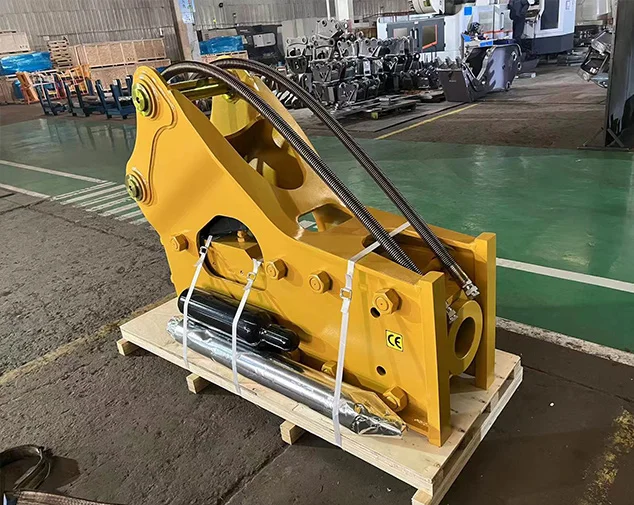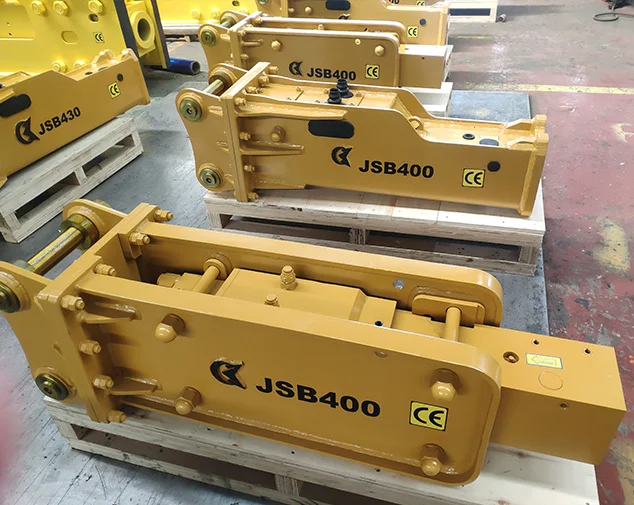What Is a Hydraulic Rock Hammer for Excavators and How Does It Work?
In the big, tough world of building, tearing down, and digging, hydraulic rock hammers are super cool tools. They’re also called hydraulic breakers. These awesome attachments turn excavators into rock-smashing machines. They can bust through the hardest ground or stuff like concrete. This guide will tell you what hydraulic rock hammers are, how they do their job, and why Kingho makes some of the best ones around. Whether you’re breaking rocks or ripping up old roads, these hammers are a big help. Let’s start!
What Is a Hydraulic Rock Hammer?
A hydraulic rock hammer is a strong tool that hooks onto an excavator. It uses high-pressure oil to make hard hits with a chisel or piston. Sometimes people call it a hydraulic breaker. It’s super important for smashing rocks, concrete, or asphalt at building sites, quarries, or mines.
The first hydraulic breaker came out in 1967 from a company called Krupp (now part of Atlas Copco). Since then, these tools have gotten way better. Now they’re stronger, quieter, and work faster. Kingho makes theirs tough and ready for any job.
Main Parts of a Hydraulic Rock Hammer
A hydraulic rock hammer has a few key pieces that make it work:
- Piston: This part slams hard to hit the chisel.
- Valve System: It controls how the oil moves inside the hammer.
- Accumulator: Holds nitrogen gas to store power and soften hits.
- Chisel/Tool: The pointy end that breaks rocks or concrete.
- Housing: Covers everything and keeps it quiet and steady.
Kingho builds their hammers with super strong Hardox steel and special 42CrMo shafts. They use fancy Swiss motors and Japanese seals to make sure the hammers last a long time, even in rough spots.
How Does a Hydraulic Rock Hammer Work?
A hydraulic rock hammer works in a cool, repeating cycle. Here’s how it goes:
- The excavator pumps hydraulic oilinto the hammer through special hoses.
- The oil pushes the pistonup, squeezing nitrogen gas in the accumulator.
- When the pressure lets go, the gas shoves the piston down super fast.
- The piston hits the chisel, smashing the rock or co
- This happens over and over, like 400 to 1200 times a minute!
Kingho offers three types of hammers: side-type (small and great for tight spots), top-type (balanced for big jobs), and box-type (quiet for city work). Each one fits different needs and rules about noise.
Where Are Hydraulic Rock Hammers Used?
Hydraulic rock hammers are super useful in lots of places:
- Building Sites: They break up foundations or old concrete slabs.
- Mines: They smash big rocks in open pits or deep underground.
- Tearing Down: They knock down buildings or tough structures.
- Digging Trenches: They make narrow, deep holes for pipes or cables.
- City Work: They fix roads, remove curbs, or help with utilities.
Kingho’s hammers work with tiny 0.8-ton excavators all the way up to giant 100-ton ones. They’re built to handle any job with ease.
Why Pick a Kingho Hydraulic Rock Hammer?
Kingho is a top-notch company that makes smart excavator tools. Their hydraulic rock hammers are awesome because:
- Theyhave ISO9001, CE, and SGS badges, so you know they’re great quality.
- They offer over 50 models, from small to huge, for all kinds of jobs.
- They can custom-make hammersto fit your exact excavator or project.
- They use Hardox steeland 42CrMo shafts for super tough hammers.
- They give great support, with tools for fixing and fast parts delivery.
Kingho’s JSB series hammers are loved by workers in Asia, Europe, and the Middle East. They’re strong and super precise, perfect for any tough job.
Tips to Keep Your Hammer Working Great
To make your hydraulic rock hammer last a long time, follow these tricks:
- Grease It Up: Put hammer grease on the chisel and bushing to stop wear.
- Don’t Dry-Fire: Don’t hit the hammer without touching material. It can break the tool.
- Check Hoses: Look for leaks or cracks that mess up the pressure.
- Store Upright: Keep the hammer standing up when not in use to avoid oil leaks.
- Clean Before Hooking Up: Make sure hoses are clean so dirt doesn’t get inside.
Kingho includes handy tools with their hammers to make these steps easy. Regular care keeps your hammer strong and ready.
Picking the Right Hammer for Your Excavator
Choosing the best hydraulic rock hammer means matching it to your excavator. You need to check the excavator’s weight, oil flow (liters per minute), and pressure (bar). A hammer too big can hurt your machine. A hammer too small won’t do the job fast.
Kingho’s catalog lists all the details for their JSB series, from the tiny JSB100 (105 kg for mini-excavators) to the huge JSB6500 (7.4 tons for big mining jobs). Each hammer is tested for flow, pressure, and hit speed to work perfectly. Kingho even helps you pick the right one for your machine.
Extra Tips for Using Hydraulic Rock Hammers
Wanna make your hydraulic rock hammer work even better? Try these ideas. Pick the right chisel for the job—moil points are great for rocks, but flat chisels work best for concrete. Check your excavator’s oil levels before starting to avoid problems. Practice with the hammer in a small area first to get the hang of it. If you’re in a noisy city, use Kingho’s box-type hammer to keep things quiet. Keep an eye on the hammer’s bolts and tighten them if they get loose. These tricks help you get the most out of your hammer and finish jobs fast.
Why Hydraulic Rock Hammers Are a Big Deal
Hydraulic rock hammers make excavators way more useful. They can smash through stuff that regular tools can’t handle. With a hammer, you don’t need extra machines or workers, so you save time and money. They’re super tough and can work in crazy conditions, like super hard rocks or freezing ground. Plus, they’re precise, so you can break just what you need without messing up other stuff. Kingho’s hammers are extra special ‘cause they’re built to last and work great every time.
More About Kingho’s Awesome Features
Kingho doesn’t just make good hammers—they make the best! Their JSB series comes in tons of sizes, so there’s one for every job. They use fancy tech, like Swiss motors and Japanese seals, to keep things running smoothly. Their hammers are built to handle super tough jobs, like mining or tearing down big buildings. Kingho also tests every hammer to make sure it hits hard and stays strong. If something breaks, they send parts fast and help you fix it. That’s why workers all over the world trust Kingho.
Conclusion
Hydraulic rock hammers are must-have tools for big digging and breaking jobs. They make excavators super strong and help finish projects faster. By picking a trusted company like Kingho, you get a hammer that’s tough, safe, and works great for years. Whether you’re smashing rocks, tearing down walls, or digging trenches, Kingho’s hydraulic rock hammers are the way to go.
FAQs
Q1: How do I know which hydraulic rock hammer fits my excavator?
Check your excavator’s weight, oil flow (liters per minute), and pressure (bar). Match them to the hammer’s needs. Kingho’s catalog has guides to help you pick the right JSB model.
Q2: What’s the difference between top-type, side-type, and box-type hammers?
Top-type is balanced for big jobs. Side-type is small for tight spots. Box-type is quiet for city work.
Q3: Can I use the same chisel for concrete and rock?
Not really. Moil or conical chisels are best for rocks. Flat or blunt chisels work better for concrete.



